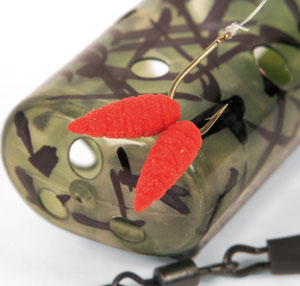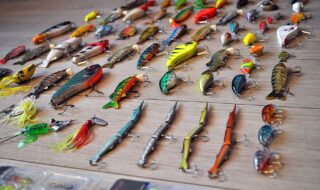How to catch big barbel on maggots
Ian Welch outlines how he sets up a tangle-free rig for barbel when targeting them in clear water with a maggot feeder set-up.
Despite the increasing use of pellets in barbel fishing there are still occasions when only the maggot feeder will do the business.
Make no mistake, a steady trickle of grubs through a swim will get the barbel nosing out of their cover and digging up the gravel better than anything else.
Maggots exert an almost hypnotic effect on barbell, and when allowed to feed in an unpressured situation they soon overcome much of their natural caution.
To create that feeding situation I usually spend an hour or so casting just the feeder full of maggots without attaching my hooklength.
Only after I’ve created the feeding situation do I clip on the hooklength and get stuck in!
The maggot feeder works best in daylight where there is some degree of clarity in the water and this rig incorporates features designed to make it unobtrusive to a browsing fish. It is also tangle-free and casts like a missile!
The base of the rig is a 2oz Drennan oval blockend; this holds station in all but the fiercest currents and creates a perfect bolt effect when fished below a semi-fixed hooklength.
I use a marker pen to break up the profile of the feeder and combine it with a Korda Safe Zone leader. This is heavy and is fished directly above the feeder to pin down the rig and prevent line bites. If barbel rub the line they invariably spook and move back into cover; it could take another hour to get them out again, so in most situations I would advise pinning the line to the bottom above the rig when targeting barbel.
A size 12 Korum S3 hook gives the perfect combination of strength with subtlety at the business end, and I combine it with 45cm of Preston’s 0.192mm Grand Match fluorocarbon, which sinks like a stone and is almost totally invisible underwater – the perfect daytime trap.
I use real maggots in the feeder to create the feeding frenzy, but Enterprise rubber grubs (see this month’s tcf Bait Guide) as hook baits, which help neutralise the weight of the hook and prevent repeated destruction by minnows and small silvers.
To put together the rig you need:
• Korum S3 Hooks in size 12
• 0.192mm (7.04lb) Preston Grand Match Fluorocarbon for the hooklength
• Enterprise Tackle’s rubber grubs
• A 2oz Drennan oval blockend feeder
• A Korda tail rubber
• Korda Safe Zone leader
• A silicone sleeve
• A small quick link
• A hooklength clip
• A size 8 ring swivel
 |
Step 1
Attach the quick link to the Safe Zone leader by threading it onto the larger of the two leader loops. Your reel line is attached to the smaller leader loop. |
|
 |
Step 2
Using a permanent marker pen break up the outline of your feeder to increase the camou effect – you don’t have to be a Picasso! |
|
 |
Step 3
Now attach the feeder to the quick link. The offset tag makes it easy to change during your session, if necessary. |
|
 |
Step 4
Thread the tail rubber onto a gate latch baiting needle, pointed end first. |
|
 |
Step 5
Grab the smaller leader loop with the hook at the end of the baiting needle. |
|
 |
Step 6
Slide the tail rubber down the needle and onto the leader. |
|
 |
Step 7
Now slide the tail rubber all the way down the leader and push it firmly over the quick link to give a seamless join between leader and feeder. |
|
 |
Step 8
Thread the ring end of a size 8 flexi ring swivel onto the leader and slide it down to the tail rubber. |
|
 |
Step 9
Slide the ring down to the bottom of the leader and ease it over the end of the tail rubber. Don’t force it, just allow it to rest snugly. |
|
 |
Step 10
Attach a hooklength clip to the other end of the swivel. This is the attachment point for your hooklength. |
|
 |
Step 11
This is what the business end should look like when finished. |
|
 |
Step 12
Tie a size 12 Korum S3 hook onto a 45cm length of 0.192mm Grand Match Fluorocarbon using your favourite knot. I prefer a six-turn grinner. |
|
 |
Step 13
Slide a 2cm length of silicone tube over the hooklength. |
|
 |
Step 14
Now tie a figure of eight loop. This allows for easy hooklength changes if you need to replace your hook during the session. |
|
 |
Step 15
Pinch the hooklength clip to open it and carefully attach your hooklength via the loop. |
|
 |
Step 16
Slide the silicone sleeve up and ease it over the hooklength swivel to give a tangle-free finish. Use saliva to lubricate it, if necessary. |
|
 |
Step 17
Rubber grubs finish the rig off. I start off with two, but if the barbel are being particularly cagey I will go down a hook size and fish a single instead. |
|
 |
Step 18
The finished rig ready to go and catch you a Korum Challenge badge-winning barbel. |
|
























